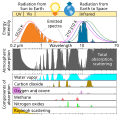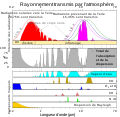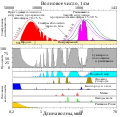Tập tin:Atmospheric Transmission.svg

Kích thước bản xem trước PNG này của tập tin SVG: 614×600 điểm ảnh. Độ phân giải khác: 246×240 điểm ảnh | 491×480 điểm ảnh | 786×768 điểm ảnh | 1.048×1.024 điểm ảnh | 2.096×2.048 điểm ảnh | 741×724 điểm ảnh.
Tập tin gốc (tập tin SVG, 741×724 điểm ảnh trên danh nghĩa, kích thước: 321 kB)
Lịch sử tập tin
Nhấn vào ngày/giờ để xem nội dung tập tin tại thời điểm đó.
| Ngày/giờ | Hình xem trước | Kích cỡ | Thành viên | Miêu tả | |
|---|---|---|---|---|---|
| hiện tại | 16:19, ngày 18 tháng 4 năm 2023 |  | 741×724 (321 kB) | Efbrazil | Adding white background color so renders correctly on smartphone |
| 20:29, ngày 7 tháng 8 năm 2022 |  | 741×724 (321 kB) | Efbrazil | color bug fix | |
| 20:00, ngày 7 tháng 8 năm 2022 |  | 741×724 (321 kB) | Efbrazil | Fixed translations as best as possible using text editor for new layout | |
| 19:34, ngày 7 tháng 8 năm 2022 |  | 741×724 (320 kB) | Efbrazil | Fixing text alignment | |
| 19:26, ngày 7 tháng 8 năm 2022 |  | 741×724 (320 kB) | Efbrazil | Graphical improvements as per discussion page | |
| 17:59, ngày 17 tháng 2 năm 2022 |  | 741×724 (208 kB) | Pierre cb | File uploaded using svgtranslate tool (https://svgtranslate.toolforge.org/). Added translation for fr. | |
| 22:10, ngày 18 tháng 3 năm 2021 |  | 741×724 (180 kB) | Cepheiden | german labels adjusted | |
| 22:09, ngày 18 tháng 3 năm 2021 |  | 741×724 (180 kB) | Cepheiden | correction of labels | |
| 22:06, ngày 18 tháng 3 năm 2021 |  | 741×724 (180 kB) | Cepheiden | File uploaded using svgtranslate tool (https://svgtranslate.toolforge.org/). Added translation for de. | |
| 21:52, ngày 18 tháng 3 năm 2021 |  | 741×724 (154 kB) | Cepheiden | =={{int:filedesc}}== {{Information |description= {{en|1=This figure shows the absorption bands in the Earth's atmosphere (middle panel) and the effect that this has on both solar radiation and upgoing thermal radiation (top panel). Individual absorption spectrum for major greenhouse gases plus Rayleigh scattering are shown in the lower panel.}} |date=2021-03-18 |source=This figure was prepared by Robert A. Rohde for the Global Warming Art project. |author=[[User:Д.Ил... |
Trang sử dụng tập tin
Chưa có trang nào ở Wikipedia tiếng Việt liên kết đến tập tin này.
Sử dụng tập tin toàn cục
Những wiki sau đang sử dụng tập tin này:
- Trang sử dụng tại ar.wikipedia.org
- Trang sử dụng tại de.wikipedia.org
- Trang sử dụng tại el.wikipedia.org
- Trang sử dụng tại en.wikipedia.org
- Trang sử dụng tại fr.wikipedia.org
- Trang sử dụng tại gl.wikipedia.org
- Trang sử dụng tại ha.wikipedia.org
- Trang sử dụng tại ig.wikipedia.org
- Trang sử dụng tại pt.wikipedia.org
- Trang sử dụng tại simple.wikipedia.org
- Trang sử dụng tại zh.wikipedia.org










